Curious about how much it costs to develop a travel app in 2025? Let’s break it down!
The cost to develop a travel app in 2025 runs from $40,000 to $250,000 or more, based on factors like app complexity, wanted features, and platform options, be it Android, iOS, or both.
But why do these numbers change so much?
It’s a mix of elements: the complexity of design, level of customization, backend development, and the experience of your mobile app makers team.
Advanced features like real-time bookings, locations, AI-based travel suggestions, and secure payment methods can greatly increase the cost of building a travel app.
App store compliance, third-party API integration, and a sleek UX/UI also add to the estimated development cost of a travel app.
But remember, it’s not just about the price, it’s about building an amazing travel experience. Ready to take off? Let’s explore the real benefits of a travel app!
Are Travel Apps a Good Investment in 2025?
Absolutely! The travel app market is rising, and 2025 is the best time to take the tech train.
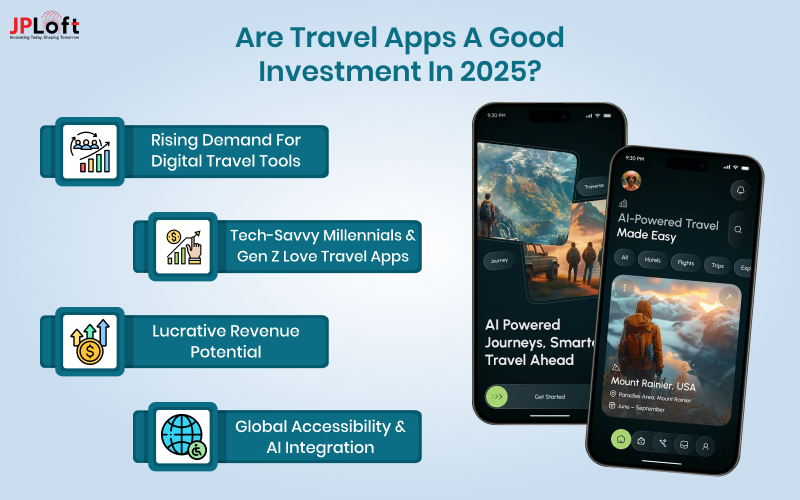
Here’s why the cost to develop a travel app is more of an investment than an expense:
A] Rising Demand for Digital Travel Tools
From solo travelers to digital nomads, everyone seeks smart, easy travel planning. A well-built app with real-time information, schedules, and bookings meets this demand head-on.
B] Tech-Savvy Millennials & Gen Z Love Travel Apps
These groups value user experience and customization, two things travel apps can offer when built with today’s tech.
C] Lucrative Revenue Potential
With mobile app monetization models like membership, fees, and ads, the cost to build a travel app in 2025 often pays for itself quickly.
D] Global Accessibility & AI Integration
AI-driven features and global reach, powered by intelligent AI services, make the travel app development cost worth every penny, giving you access to a massive, eager audience.
Average Cost to Develop a Travel App in 2025
The cost to build a travel app in 2025 usually runs from $40,000 to $250,000+, based on your app’s complexity, features, and platform (Android, iOS, or cross-platform).
So, what drives these numbers up (or down)? It’s all in the details, like your design, the development team's experience, and your app's usefulness.
Let’s break down the estimated development cost of a travel app by stage:
|
Development Stage |
Description |
Estimated Cost (USD) |
|
Planning & Research |
Market research, user persona creation, and competitive analysis |
$5,000 - $15,000 |
|
UI/UX Design |
Wireframing, prototyping, and designing the app’s travel-friendly interface |
$8,000 - $20,000 |
|
Frontend Development |
Building sleek interfaces for iOS, Android, or both |
$10,000 - $35,000 |
|
Backend Development |
Databases, servers, APIs, geolocation, and travel integrations |
$15,000 - $40,000 |
|
Core Travel Features |
Itinerary builder, hotel/flight booking, maps, user accounts |
$10,000 - $30,000 |
|
Advanced Integrations |
AI-based suggestions, AR navigation, third-party APIs |
$15,000 - $50,000 |
|
Payment Gateway Integration |
Secure booking payments, wallet options, and subscriptions |
$5,000 - $12,000 |
|
Testing & QA |
Functionality, performance, and mobile app security checks |
$6,000 - $15,000 |
|
Deployment |
Launching the app on Google Play and the Apple App Store |
$2,000 - $6,000 |
|
Post-Launch Support & Maintenance |
Bug fixes, mobile app maintenance costs, and feature updates |
$5,000 - $25,000+ |
How much does it cost to develop a travel app in 2025? It is one of the first things that comes to mind when you're planning to create one.
The complexity, platforms, and features you want to offer your users who are always wanting to travel will determine the answer. Let's break it down:
► Basic App Development
The cost to make a travel app typically ranges from $40,000 to $70,000 if you want to create a simple travel app with key features like flight search, hotel ads, booking management, and an easy UI/UX.
Businesses looking to test the market without making a significant initial investment should look at this price range.
It lets you get started quickly, get useful feedback from users, and test your idea before it grows.
You can try out and improve your idea while getting ready for more advanced features in the future with a basic app.
► Mid-Level App Development
The cost to create a travel app in 2025 typically ranges from $70,000 to $120,000 for businesses looking to connect travelers on a deeper level.
These features include trip planning, real-time weather reports, AI-driven suggestions, and multi-language support.
With features like smart suggestions, personalized route planning, and improved mobile app development functionality, this investment allows businesses to give a better user experience.
► Advanced, Feature-Rich App Development
If you're looking to create a premium, high-end travel app with advanced features like AI-powered planning, AR guidance, loyalty systems, and smooth payment method integration.
It also has multi-platform support, including iOS app development and Android app development. The cost to create a travel app can range from $120,000 to $250,000 or more.
This level is great for businesses hoping to dominate the travel app market with cutting-edge, user-focused solutions.
It’s ideal for those who want to give a better, feature-rich experience while maintaining a strong competitive edge.
With top-tier features and improved mobile app security, this investment ensures your travel app stands out.
By combining the latest tech, you’ll offer a smooth, safe, and efficient user experience.
|
Development Stage |
Estimated Cost Range |
|
Basic App Development |
$40,000 - $70,000 |
|
Medium Complexity App |
$70,000 - $120,000 |
|
High-End Feature-Rich App |
$120,000 - $250,000+ |
Understanding the cost to create a travel app in 2025 helps you spend smartly and invest in the features that truly matter.
Whether you're planning a simple trip tool or an all-in-one travel buddy, the cost to develop a travel app relies on your business goals, feature set, and tech partner.
Key Factors Affecting the Cost of Travel App Development
Several key factors play a significant role in determining the cost of developing a travel app.
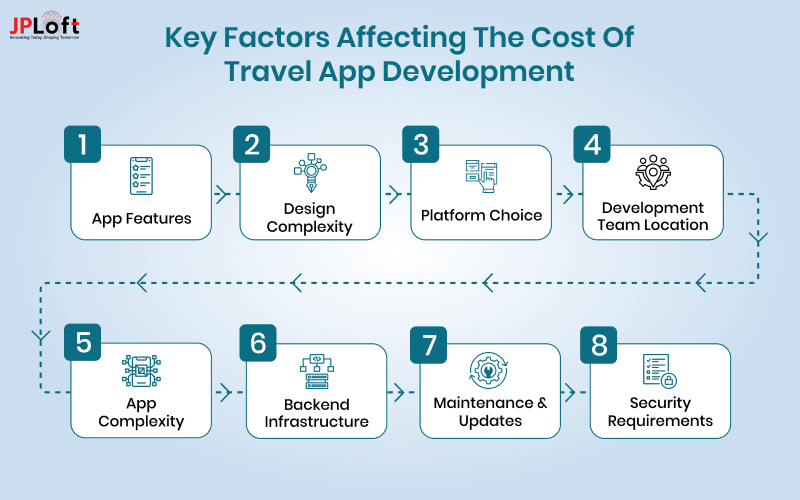
Let’s break down these crucial elements that will impact your development costs:
1. App Features
The features you add to your travel app directly impact its development cost. Basic travel apps with basic features, such as hotel booking, flight search, and location maps, are cheaper.
However, if you're looking to include advanced features like AI-powered tips, real-time weather updates, dynamic maps, or personalized trip plans, expect a major increase in development costs.
These advanced tools require more complicated coding, merging, and testing, all of which add to the overall budget.
|
Feature |
Impact on Cost |
|
Hotel Booking & Flight Search |
Low |
|
Location Maps |
Low to Medium |
|
AI-Powered Recommendations |
High |
|
Real-Time Weather Updates |
Medium to High |
|
Personalized Trip Planners |
High |
2. Design Complexity
A clean, user-friendly design is important for the success of your travel app.
The complexity of the design, such as unique UI/UX elements, images, and interesting features, directly affects the development costs.
A simple, clean layout with basic scrolling usually costs less.
However, during the planning stage, app wireframing and building an app prototype are crucial to visualizing the app’s features and flow.
A highly customized, dynamic design aimed at delivering an outstanding user experience can significantly raise your development budget.
The busier and more visually interesting the design, the more time, effort, and resources it takes to develop and maintain.
|
Design Element |
Impact on Cost |
|
Simple Layout & Basic Navigation |
Low |
|
Custom UI/UX |
Medium to High |
|
Animations & Interactive Features |
High |
3. Platform Choice (iOS, Android, or Both)
The platform you choose for your travel app, whether iOS, Android, or both, will directly impact the development cost.
Building an app for both platforms takes more resources and experience, which naturally increases the total price.
Developing a native app for each platform includes different codebases, design tweaks, and app testing methods for each.
On the other hand, going for a cross-platform app can greatly lower costs since you only need to maintain one codebase for both iOS and Android.
However, cross-platform development still requires careful optimization to ensure smooth performance across devices and screen sizes, which may add extra complexity to the project.
|
Platform Choice |
Impact on Cost |
|
Single Platform (iOS or Android) |
Medium |
|
Cross-Platform (iOS & Android) |
Medium to High |
4. Development Team Location
The geographical location of your development team plays a major part in setting the cost of building your travel app.
For instance, developers in North America or Western Europe usually charge higher hourly rates compared to those in Eastern Europe and Asia.
If you're looking to hire mobile app developers, moving to areas with lower labor costs can help reduce your total budget.
However, it’s important to strike a mix between cost and knowledge.
Choosing the right team with a proven track record in app development ensures your app meets top-tier quality standards, no matter where your developers are located.
|
Location |
Impact on Cost |
|
North America/Western Europe |
High |
|
Eastern Europe |
Medium |
|
India/Southeast Asia |
Low |
5. App Complexity
The complexity of your travel app grows as you add more features and functions.
Apps that integrate real-time data, GPS tracking, AI-driven recommendations, multi-language support, and strong back-end systems take more development time, technical knowledge, and resources.
These advanced features increase the general complexity of the app, driving up both the development time and cost.
While these features can improve the user experience and set your app apart, they also demand careful planning, testing, and ongoing app maintenance.
|
Feature/Functionality |
Impact on Cost |
|
Basic Features (Flight Search, Booking) |
Low to Medium |
|
Real-Time Data Integration |
Medium |
|
GPS Tracking & AI Recommendations |
High |
|
Multi-Language Support & Back-End Systems |
Very High |
6. Backend Infrastructure
For travel apps that require cloud storage, real-time changes, or need to handle big amounts of user data or bookings, the backend infrastructure plays a crucial part in cost.
The more solid and flexible the system, the higher the costs associated with setting up and maintaining servers, APIs, and database infrastructure.
A good backend is important for ensuring the app’s stability, scaling, and performance, especially as user demand grows.
Whether it's ensuring real-time syncing across devices or supporting complicated deals, investing in a powerful backend is important, but it can greatly increase development and running costs.
|
Backend Requirement |
Impact on Cost |
|
Basic Backend (Limited Storage, Basic Data) |
Low |
|
Cloud Storage & Real-Time Updates |
Medium |
|
Scalable Backend for Large Volumes |
High |
7. Maintenance and Updates
Travel apps require regular maintenance to ensure interaction with new operating systems, fix bugs, and update features.
Ongoing mobile app maintenance is a crucial part of the long-term cost and should be considered when planning for app development.
As working systems grow and user standards change, keeping your app up-to-date is important for ensuring it stays useful, safe, and competitive.
Maintenance costs can vary based on the complexity of the app, with more feature-rich or dynamic apps needing higher care.
Budgeting for this ongoing cost is key to supporting the app’s performance and user involvement over time.
|
Maintenance Requirement |
Impact on Cost |
|
Basic Updates & Bug Fixes |
Low to Medium |
|
Feature Updates & Compatibility |
Medium |
|
High-End Maintenance (Real-Time Sync, New Features) |
High |
8. Security Requirements
App Security is a critical aspect of any travel app, especially those that handle sensitive user data like payment information, bookings, and personal details.
Implementing strong security features, such as secure payment methods, user data encryption, and compliance with data protection laws, adds to the total development cost.
While these steps increase the budget, they are important for building user trust, ensuring data privacy, and meeting legal requirements.
Investing in top-tier security helps avoid data breaches, protects your users, and improves the trustworthiness of your app, eventually adding to its long-term success.
|
Security Features |
Impact on Cost |
|
Basic Security Measures (SSL, Basic Encryption) |
Medium |
|
Advanced Security (Data Encryption, Payment Gateway Integration) |
High |
By carefully considering these factors, you can get a clearer picture of how much does it cost to build a travel app and make informed decisions about where to allocate resources effectively.
Hidden Travel App Development Cost You Should Know About
When calculating the cost to develop a travel app, it’s easy to focus on upfront expenses like design, features, and core development.
However, several hidden costs often go unnoticed, and they can significantly impact your total budget if not planned for in advance.
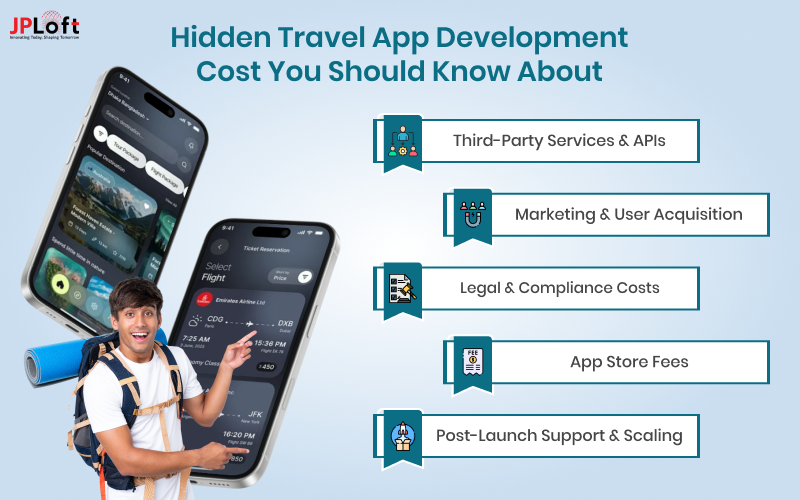
To help you stay on top of your travel app’s financial plan, here’s a list of typically forgotten expenses:
► Third-Party Services & APIs
Enhancing your app’s usefulness often means integrating third-party APIs, such as hotel booking engines, flight aggregators, map services, or weather updates.
While these integrations improve user experience, they often come with usage-based or membership fees.
-
Payment platforms (Stripe, Razorpay, PayPal) charge around 2.5%-3% per transaction.
-
Geo-location services or real-time flight trackers can add monthly or per-use costs.
-
SMS verification (e.g., Twilio) usually costs $0.0075 per message, which grows with your user group.
Failing to include these in your budget could lead to unexpected operational costs down the line.
► Marketing & User Acquisition
Even the most feature-rich travel app won’t work without a strong start and a user growth plan. Marketing costs can change widely based on your approach:
-
Social media campaigns: $2,000–$10,000/month.
-
Influencer or travel blogger collaborations: $500–$5,000 per campaign.
-
App Store Optimization (ASO): $1,000–$3,000.
Effective marketing ensures your app gets found in a competitive area, but it also requires a constant budget to feed growth.
► Legal & Compliance Costs
Travel apps often handle sensitive personal and financial data. Ensuring compliance with GDPR, CCPA, and other international data protection regulations is vital.
-
Legal consultancy: $5,000–$10,000
-
Drafting Terms & Conditions and Privacy Policy: $1,000–$3,000
Investing in legal protection upfront reduces risk and builds user trust over time.
► App Store Fees
To publish your app on the Google Play Store or App Store, consider platform-specific fees:
If you’re looking to submit an iOS app to the App Store, remember to account for Apple's developer fees and guidelines.
-
Apple Developer Program: $99/year
-
Google Play Developer Account: $25 one-time fee
These may seem minor, but they are necessary for deployment and ongoing updates.
► Post-Launch Support & Scaling
After your app goes live, unexpected issues can arise. Whether it’s fixing bugs or scaling servers to handle increased traffic, costs can mount quickly:
-
Bug fixes: $2,000–$5,000 per patch
-
Scaling infrastructure: $10,000–$20,000, depending on user growth
We recommend allocating 10–15% of your total budget as a contingency for unforeseen post-launch needs.
Popular Travel Apps and Their Development Costs
When planning your travel app, it’s smart to take a cue from successful travel platforms that have made waves in the industry.
By knowing what features they offer and how much it likely costs to develop them, you can better shape your project and budget.
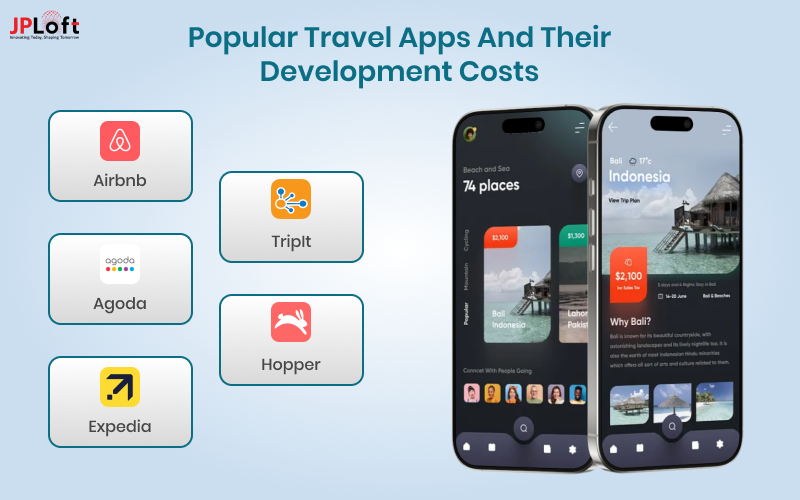
Here’s a list of some top travel apps and their estimated development costs:
1. Airbnb
Globally renowned for its vacation rental model, Airbnb joins travelers with hosts worldwide.
It has an easy booking process, secure in-app communication, and detailed property ads that let users look at homes in more detail before making a reservation.
Building trust, user experience, and scalable server systems to support real-time access and global transactions are all important considerations if you want to create an app like Airbnb.
Key Features:
-
Host and guest dashboards
-
Real-time booking system
-
Secure in-app messaging
-
Dynamic pricing, reviews & ratings
-
Advanced search and map-based listings
-
Multilingual and multi-currency support
Estimated Development Cost: $80,000–$150,000
2. Agoda
Agoda is a widely recognized travel booking platform that is well-known for its hotel bookings, flight bookings, and vacation rental deals.
Known for its strong foothold in Asia and reasonable price, it offers a sleek user experience, powerful searching, and real-time booking capabilities.
To create an app like Agoda, focus on smooth UI/UX, powerful search features, and secure payment integration.
Key Features:
-
Hotel and flight bookings
-
Geo-based personalized deals
-
Currency and language localization
-
Interactive map for hotel search
-
Loyalty rewards and a coupon system
-
In-app customer support and chatbot
Estimated Development Cost: $25,000 to $150,000
3. Expedia
Expedia is a comprehensive travel app offering everything from flights and hotels to vacation packages and car rentals.
Known for its huge selection of services, Expedia makes booking trips quick and easy.
Additionally, its loyalty programs reward regular travelers with exclusive benefits, making it a top choice for anyone planning their next trip.
Key Features:
-
Multi-service travel booking
-
Flight/hotel bundles
-
Price comparison tools
-
Loyalty rewards integration
Estimated Development Cost: $100,000–$250,000
4. TripIt
TripIt improves global travel by instantly turning your emails into detailed travel plans.
Ideal for business and regular foreign travelers, it groups flight information, hotel bookings, car rentals, and more in one handy place, helping you stay organized and stress-free throughout your trip.
Key Features:
-
Auto itinerary creation
-
Email sync and calendar export
-
Real-time travel updates
-
Offline access
Estimated Development Cost: $80,000–$150,000
5. Hopper
Create a travel app like Hopper, a widely popular travel app known for its AI-powered predictions that help users book flights and hotels at the lowest possible prices.
It’s great for budget-conscious travelers who value smart, data-driven choices.
With a clean design and real-time changes, Hopper gives users a smooth experience from search to booking.
Key Features:
-
Flight and hotel price prediction
-
Fare tracking alerts
-
In-app booking system
-
Real-time push notifications
Estimated Development Cost: $150,000–$250,000
Want to create a travel app like Hopper? You’ll need smart algorithms, intuitive UX, and robust data integrations.
How to Minimize the Travel App Development Cost Without Sacrificing Quality?
Creating a travel app is an exciting business opportunity, but keeping a close eye on the travel app development cost is essential to avoid unexpected budget overruns and ensure long-term success.
With smart planning and strategic choices, you can reduce expenses without compromising on user experience or performance.
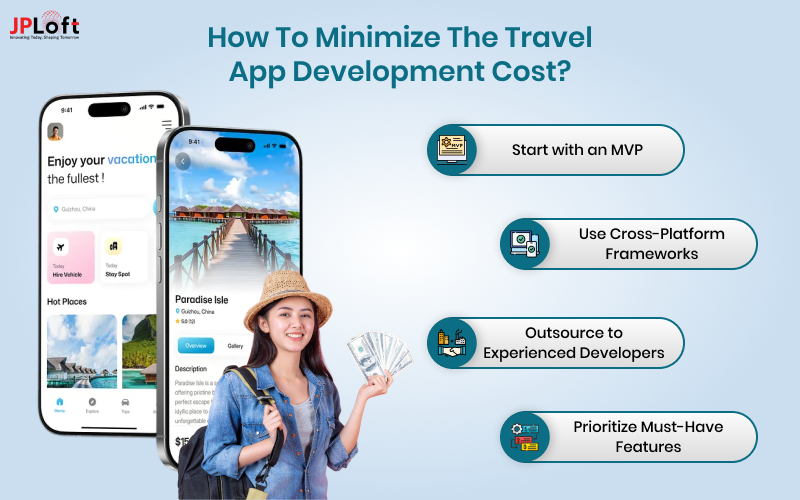
Here’s how to cut costs while still building a top-notch travel app:
A] Start with an MVP (Minimum Viable Product)
Launching with an MVP helps you focus on key features like hotel booking, flight search, directions, and user registration.
These basics are enough to try your concept, gather user feedback, and confirm your idea, keeping original costs around $40,000 to $75,000.
You can later improve the app with things like AI-driven schedules, AR-guided trips, or reward programs as your user base grows.
B] Use Cross-Platform Frameworks
Save both time and money by developing your app with frameworks like Flutter or React Native.
These tools allow you to build for iOS and Android simultaneously, removing the need for different codebases.
Cross-platform development can reduce costs by up to 40%, bringing your original budget to a more doable $70,000 - $120,000, based on features.
C] Outsource to Experienced Developers
Hire mobile app developers from areas like Eastern Europe or Southeast Asia, where hourly rates run from $25 to $60.
Look for mobile app developers with experience in travel apps, as they'll know the ins and outs of must-have features like booking systems, location services, and payment connections.
Outsourcing lets you tap into global talent while keeping your development cost-effective and high-quality.
D] Prioritize Must-Have Features
Cost to create a travel app can be kept in check by focusing first on must-haves like booking engines, GPS integration, and secure payments.
Advanced features like AI chatbot, or changeable price can be added post-launch.
This method keeps your MVP budget-friendly and scalable, allowing you to add premium features as your app grows.
By starting small, using cost-saving tech, and outsourcing wisely, you can build a high-quality travel app without blowing your budget.
These tactics ensure that your app stays lean, user-friendly, and competitive, ready to grow without financial pressure.
How Travel Apps Make Money?
Travel apps aren't just about helping users plan trips; they're also built to be smart money-making machines.
This is where mobile app monetization comes into play: strategies that turn user engagement into steady revenue streams.
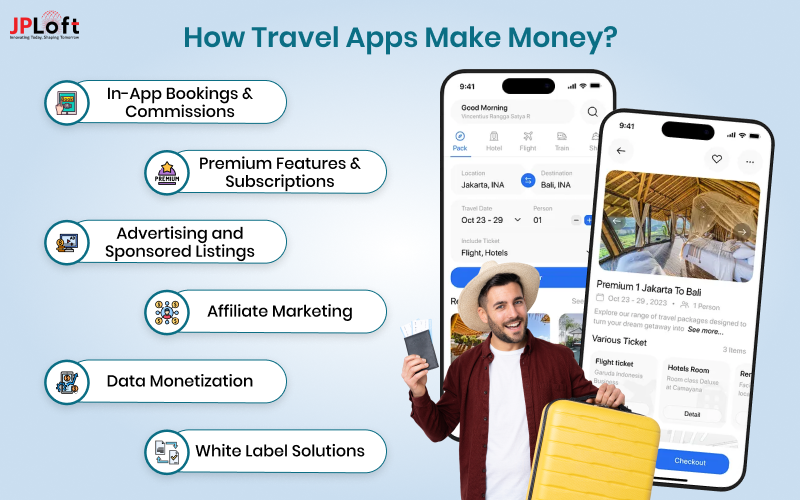
Wondering how your future travel app can bring in revenue? Let's break down the most common (and clever) ways travel apps make money:
-
In-App Bookings & Commissions: The most direct way to make money is by letting users book flights, hotels, car rentals, or trips within the app. Every time a user completes a booking, the app charges the service provider a fee. Apps like Booking.com and Agoda thrive on this model.
-
Premium Features & Subscriptions: Many travel apps offer basic access for free but lock special features behind a paywall. Think AI-based trip planning, offline access to maps, or VIP customer service. Subscription plans or one-time sales can slowly bring in income while giving more value to users.
-
Advertising and Sponsored Listings: Like Google search, travel apps often show sponsored results, whether it’s a hotel paying to be at the top of the list or a tour company pushing their services. Banner ads and native ads also add a stream of income, especially for apps with high usage.
-
Affiliate Marketing: Apps link users to third-party platforms like insurance providers, visa services, or bag companies and earn a fee on each sale. It’s smooth and successful.
-
Data Monetization: With user consent, anonymous data can be shared with travel experts or companies to understand travel trends. Always value user privacy and follow GDPR/CCPA rules.
-
White Label Solutions: Some travel platforms sell their software or features to other companies looking to build branded travel apps. A solid source of B2B cash!
Why Choose JPLoft for Your Travel App Project?
Ready to build the next big travel app like Hopper or Visit Dubai?
JPLoft is your go-to travel app development company, providing smart, scalable, and secure mobile solutions.
Whether you need AI-driven features, real-time bookings, or beautiful UI/UX across Android and iOS, our expert team has you covered.
We blend technical excellence with user-focused design to ensure your app stands out in the global market.
Let’s bring your travel app idea to life, connect with us today, and start your journey to digital success!
Conclusion
So, how much does it cost to create a travel app in 2025? The answer varies based on features, platforms, and development needs.
But with smart planning, the right tech stack, and an experienced team, you can build a powerful, user-friendly app without draining your budget.
Whether you’re estimating how much does it cost to build a travel app or still brainstorming your app concept, now is the perfect time to get started.
A well-executed travel app can open the door to global audiences and steady revenue, but you should be sure to start with a clear vision and strong development strategy.
FAQs
The cost to build a travel app ranges between $40,000 and $250,000+, depending on design, features, platform choice, and development region. Complex apps with AI or AR features tend to cost significantly more.
Absolutely! Starting with an MVP, choosing cross-platform tools like Flutter, and outsourcing to skilled yet affordable developers can help maintain quality while keeping costs manageable.
Implement encrypted databases, secure payment gateways, compliance with privacy laws, and regular updates. These measures protect user data and boost trust in your mobile travel application.
High-end features like AI, AR navigation, loyalty programs, real-time tracking, custom backend systems, and post-launch maintenance can all increase the overall development budget.
Typically, it takes 3 to 9 months to develop a fully functional travel app, depending on the features, complexity, and platform choices.





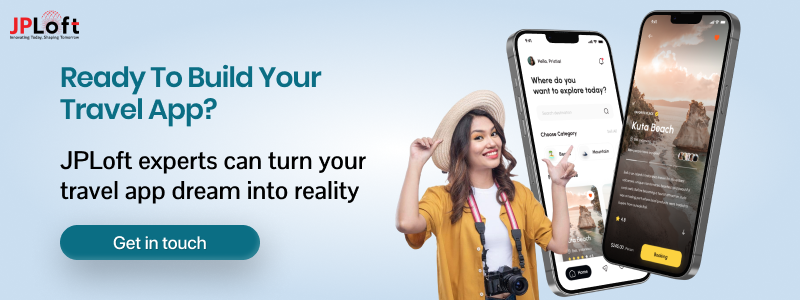
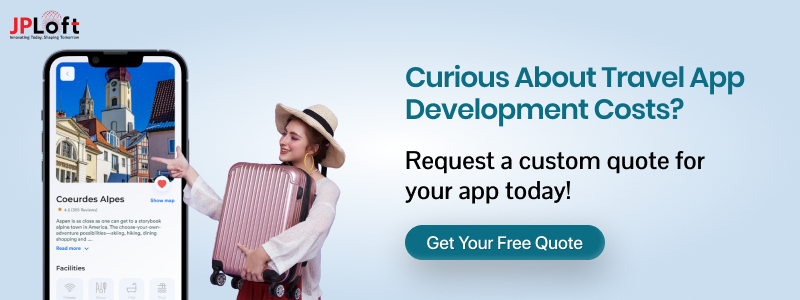
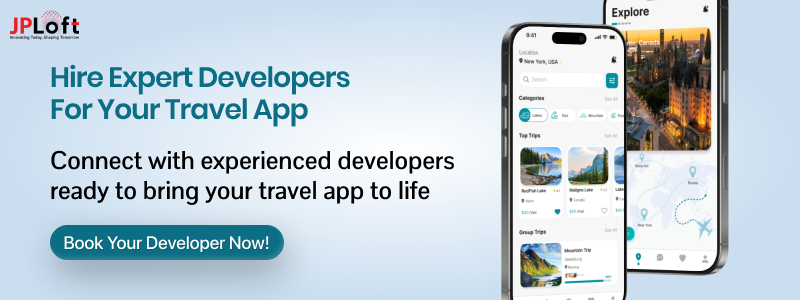

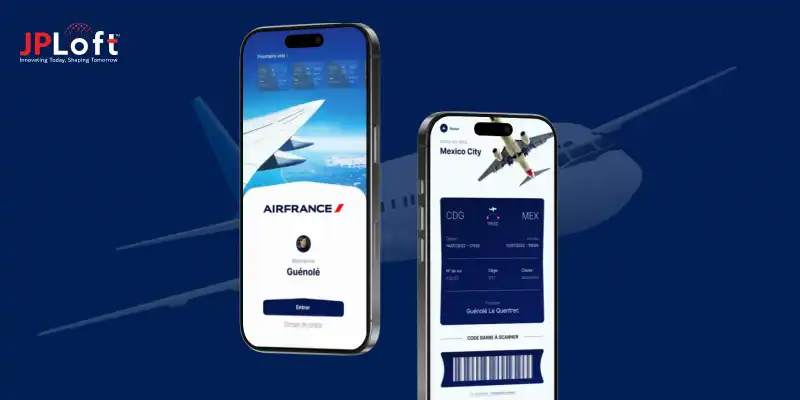
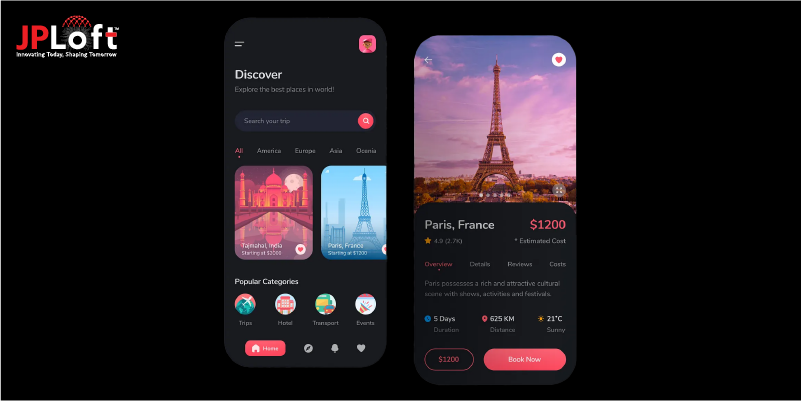
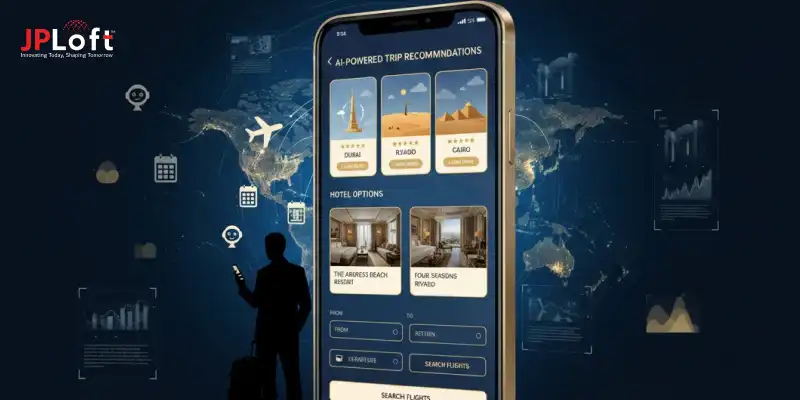


Share this blog